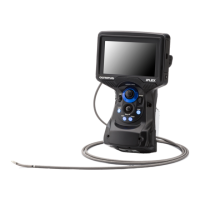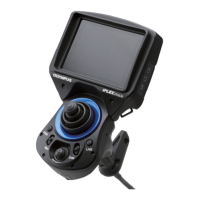108
Chapter 6 Measurement procedures
6.1 Measuring from three dimensional (3D)
coordinates (stereo measurement)
The 3D coordinates of each specified point are calculated by applying the
principles of triangulation to a set of images obtained using two objective lenses
that are set in parallax. Measurements are done based on these coordinates.
Measurement accuracy
CAUTION
• As this measurement method uses image processing technology, the measurement accuracy
is affected by the quality of the image used. Image quality varies depending on the surface
conditions of the object and image capturing conditions such as the brightness. Due to this,
Olympus cannot guarantee the accuracy of the results obtained with this measurement
method. We recommend that users identify the measurement accuracy through experiments.
To obtain more correct results, it is recommended to perform measurements using more than
one set of images captured from different viewpoints.
A pair of corresponding points (same location) in two images on the left and right
must be identified to do stereo measurements. This operation is referred to as
matching. The software is capable of automated matching. However, since it
employs image processing, it may be unable to obtain the correct corresponding
point if a similar shape exists in the proximity of the point indicated in the image.
After completion of measurement, always be sure to check the positions of the
pointers in the left and right images and confirm that they indicate the same point
on the object as the corresponding points. The measured value loses reliability if
the corresponding point is erroneous. In this case, use the correction function
which will be described later or change the viewpoints (by moving the tip of the
insertion tube) and perform the measurement again. However, matching cannot
be done for some images. For example, if the surface is reflective, such as a
clean stainless steel pipe. With such an object, try changing the viewpoints (by
moving the tip of the insertion tube) to make the measurement. This may
sometimes make correct measurement possible.
The object distance measurement calculates the distance between the distal end
of the optical adapter and the subject in a live, frozen, retrieved or stereo
measurement image. As the measurement is affected if the image of the object
is blurred, move the distal end of the insertion tube slowly. When the object
distance measurement is applied to a live image, the displayed measurement
value is measured from a few frames before the current image. Consequently, if
stereo measurement is activated while performing object distance measurement,
the object distance measurement value may differ from the stereo measurement
result of the distance between the distal end of the insertion tube and the
indicated point.

